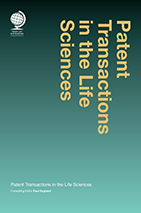Patent transactions in the life sciences
September 2014
The growth and diversification of life sciences
High research costs, complex regulatory requirements and dwindling opportunities for developing small-molecule targets: these are some of the factors blamed for the difficulties encountered by some branded pharmaceutical companies in recent years when trying to bolster the number of candidates entering and progressing through their product pipelines. At the other end of the pharmaceutical product life cycle, many of the 'blockbuster' drugs that have dominated the market in the last decade now have generic competition. Further difficulties have, of course, come from the worst economic downturn in living memory, with ensuing pressures on costs. As a result of these pressures, some companies are moving away from reliance on the traditional small-molecule pharmaceutical business model and are attempting to broaden the nature of their product offerings to, amongst other things, branded generic products, biologicals and medical devices. There have been other developments: the acquisition of small research companies with promising drug candidates has become an attractive alternative to conducting early-stage development in-house. Interest has also turned to divestment of certain business operations (see Asset-centric SPVs) and the efficiencies brought by cooperation and collaboration with third parties.
 This diversification of the traditional, small-molecules industry may have actually sustained it through the downturn. Indeed, this is the view of a major report prepared by Battelle and the Biotechnology Industry Organization in 2012 (the "Battelle Report")1, which attributes the resilience of the bioscience industry in the US to its diversity. However, innovation in this field is not restricted to the US or Europe. For example, although it has been known for many years as a centre of generic drug production, India is now seeing a number of novel drug research projects coming to fruition2, with more anticipated to follow in the coming years. Also, new levels of deal making within the sector in 2014 are attributed to a desire for efficiency, productivity and the need to reshape businesses after retrenchment in the last few years3.
This diversification of the traditional, small-molecules industry may have actually sustained it through the downturn. Indeed, this is the view of a major report prepared by Battelle and the Biotechnology Industry Organization in 2012 (the "Battelle Report")1, which attributes the resilience of the bioscience industry in the US to its diversity. However, innovation in this field is not restricted to the US or Europe. For example, although it has been known for many years as a centre of generic drug production, India is now seeing a number of novel drug research projects coming to fruition2, with more anticipated to follow in the coming years. Also, new levels of deal making within the sector in 2014 are attributed to a desire for efficiency, productivity and the need to reshape businesses after retrenchment in the last few years3.
With the time and money that is being invested in the sector and the potential commercial rewards at stake, how do those making that investment and others depending on the success of a life sciences business ensure that the innovations at the centre of their businesses provide a return for them? Furthermore, in such a competitive sector, what is to ensure that the technology being developed by one enterprise is not being appropriated by another? The answer is that where there is innovation, particularly when it has a prospect of commercial application, there is intellectual property and, in particular, patents.
The importance of patents
Patenting a technology provides exclusivity against competitors (see Using intellectual property protection). Even though patents cannot guarantee that an innovation will be commercially successful, they do ensure, if properly managed, that the rewards of a successful invention flow to the patent owner. Indeed, as the Battelle Report states, the industries in the biosciences sector are amongst those with the highest levels of patenting and this, says the report, is key to their competitive advantage in the marketplace.
The importance of patents is further explained by another report, published in January 2014 by University College London's School of Pharmacy and co-written with the London School of Economics (the "UCL Report").4 The UCL Report examines patient interests in medicines and biomedical innovation, and the extent to which these are served by intellectual property rights – in particular, patents. As the UCL Report points out, the market value placed on medicines is not a reflection of simply the cost of raw materials  and manufacture, but in the scientific challenges and material costs of their development. These include not only the preclinical developments and clinical trial costs of successful drugs but also those for drug candidates that never made it to market. The UCL Report supports the estimate that the costs of developing an innovative medicine to market are in excess of $1 billion. Hence, as the UCL Report notes, patents do not just enable rewards for innovations that are already available; patents are also important to secure the willingness of investors to continue to put large sums of money towards innovations for the future.
and manufacture, but in the scientific challenges and material costs of their development. These include not only the preclinical developments and clinical trial costs of successful drugs but also those for drug candidates that never made it to market. The UCL Report supports the estimate that the costs of developing an innovative medicine to market are in excess of $1 billion. Hence, as the UCL Report notes, patents do not just enable rewards for innovations that are already available; patents are also important to secure the willingness of investors to continue to put large sums of money towards innovations for the future.
Patents for collaboration
Patents in themselves are key, but there is more to the development of successful products than ensuring exclusivity. As the UCL Report explains, patents are recorded as a property right on a register, allowing the owner to share that information in the patent with the public at large without losing their claim to it. But, importantly for the purpose of commercial activity, this also allows patents to be dealt in with third parties as an asset, as with any other property right, or to enable the proprietor to collaborate with third parties to share the technology for the advancement of the interests of both. The fundamental ways in which this is achieved are by patent assignment, by which rights to a patented technology are transferred from one owner to another, and, by licence, in which certain rights to the patent can be granted in a controlled way to one or more third parties without ownership itself being transferred. Both methods allow the proprietor to ask for money by way of exchange; thus the patent is monetised, without a single product having been sold or, necessarily, developed.
 However, where patent assignments and licences are concerned there are also complex patent law issues to address. Parties must negotiate these in order to strike a mutually beneficial deal for the exploitation of the technology at issue. These patent issues can also be at the heart of bigger transactions in the life sciences sector, such as mergers and acquisitions, joint ventures, divestments and development agreements. An understanding of patents and successful negotiation of the issues that arise when collaborating with third parties are therefore key to success in the life sciences sector. With this in mind, German and English law experts at Taylor Wessing, together with other leading life sciences lawyers from jurisdictions around the world, have collaborated with Globe Law and Business Publishing to produce Patent Transactions in the Life Sciences – designed to provide an introduction to patents and know-how, patent agreements, and associated legal issues in the life sciences sector.
However, where patent assignments and licences are concerned there are also complex patent law issues to address. Parties must negotiate these in order to strike a mutually beneficial deal for the exploitation of the technology at issue. These patent issues can also be at the heart of bigger transactions in the life sciences sector, such as mergers and acquisitions, joint ventures, divestments and development agreements. An understanding of patents and successful negotiation of the issues that arise when collaborating with third parties are therefore key to success in the life sciences sector. With this in mind, German and English law experts at Taylor Wessing, together with other leading life sciences lawyers from jurisdictions around the world, have collaborated with Globe Law and Business Publishing to produce Patent Transactions in the Life Sciences – designed to provide an introduction to patents and know-how, patent agreements, and associated legal issues in the life sciences sector.
If you have any questions on this article or would like to propose a subject to be addressed by Synapse please contact us.
1 Battelle / Bio, " State Biosciences Industry Development 2012".
2 See Amy Kazmin, "Indian pharmaceutical groups shed copycat image", Financial Times, July 22 2013.
3 Andrew Ward, "Pharma deals reach new level of intensity", Financial Times, May 1 2014.
4 Mari Lundeby-Grepstad and David Tordrup (LSE), and Tinas Craig and David Taylor (UCL School of Pharmacy), "Patients' needs, medicines innovation and the global public's interests", January 2014.


Paul England
Paul is a senior associate and professional support lawyer in the Patents group based in our London office.
"This diversification of the traditional, small-molecules industry may have actually sustained it through the downturn"
"Where there is innovation, particularly when it has a prospect of commercial application, there is intellectual property, and, in particular, patents"

